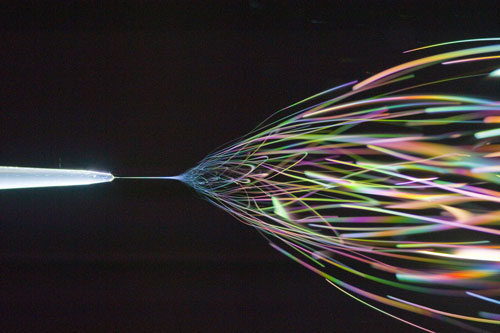Understanding Electrospinning for Nanofiber Production
Definition: Electrospinning is a versatile and efficient method for producing ultra-fine fibers, with diameters ranging from a few nanometers to several micrometers. This process leverages an electric field to draw charged threads of polymer solutions or melts to create fibers with high surface area to volume ratios. Ideal for a wide array of applications, electrospinning stands out for its simplicity, ability to produce continuous fibers, and the capability to fabricate fibers from a vast range of materials.

Basics and Mechanism of Electrospinning
Electrospinning operates on a straightforward principle involving a high-voltage electric field applied between a droplet of polymer solution (or melt) held by a syringe and a grounded collector. The electric forces overcome the surface tension of the droplet, stretching it into a thin jet. As the jet travels through air (or another medium), the solvent evaporates, leaving behind a solid fiber that collects on the substrate in a random or aligned pattern, depending on the setup.
Key Components and Process Variables
The essential components of an electrospinning setup include a high-voltage power supply, a syringe pump to feed the polymer solution, a metallic needle, and a collector.
Critical process variables influencing fiber formation include the voltage applied, the flow rate of the polymer solution, the concentration and viscosity of the solution, the distance between the needle and the collector, and environmental conditions such as temperature and humidity.
Materials and Applications
A wide variety of materials can be electrospun, including polymers, composites, and even ceramics or metals, provided they can be formed into a solution or melt with suitable properties. Applications of electrospun fibers span numerous fields such as filtration, tissue engineering, drug delivery, wound dressings, protective clothing, and sensors, highlighting the technique's versatility.
Advantages and Limitations
Electrospinning offers several advantages, including the ability to produce fibers with nanometer-scale diameters, high porosity, and large surface area, which are beneficial for many applications. However, challenges such as controlling fiber deposition and achieving uniform fiber diameters persist, and the process's scalability and productivity are areas of ongoing research.
Technological Advancements and Future Directions
Recent advancements in electrospinning technology focus on improving control over fiber alignment, diameter, and composition, as well as scaling up the process for industrial applications. Innovations include multi-needle systems for increased productivity, needleless systems to avoid jet instability, and the integration of in-line monitoring and control systems for better quality assurance.
As research continues, we can anticipate further improvements in electrospinning techniques, broadening their applicability and efficiency in producing high-quality nanofibers for a growing range of uses.
Further Reading
SN Applied Science, A review on fabrication of nanofibers via electrospinning and their applications
